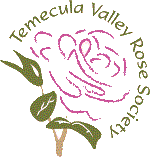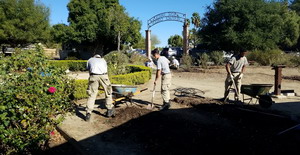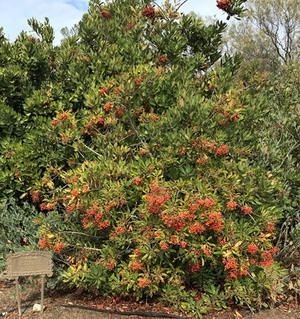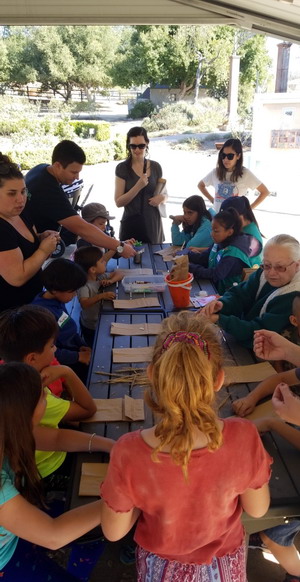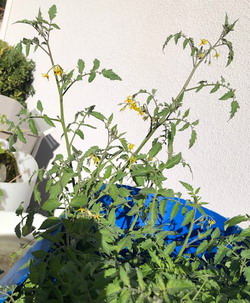Rose Care FUNdamentals
by Frank Brines, Master Consulting Rosarian

Depending on which side of the canyon you live, the past few weeks have produced much needed rain – and, for some folks, too much of a good thing. In any case, the roses are appreciating the break. After being buffeted around, shoved from hither to yon, and finally getting a great shower removing the dusty layer from more recent Santa Anas and rehydrated soil a resting period will be a welcome state. Most areas still haven't had temperatures anywhere near frost. Roses could still be seen actively growing and blooming in many Temecula Valley gardens during the Thanksgiving holiday. This cold rain and temperatures will cool the soil and reset the roses' biological clock to slow down and go into some kind of dormancy.
Roses need a four- to six-week rest or "dormancy" period during the winter months. During dormancy, the plants go through natural hormonal changes that prepare them for the next growing season. Dormancy is triggered by a variety of factors. Cold temperatures (including frost) slow the plant's metabolism while cold rains chill the soil further slowing growth rate.
You can help promote dormancy by not deadheading or pruning this month. Allow the rose "hips" to set and mature so they can send hormonal signals to the plant that it's time to rest and marshal it's energy for a vigorous growth spurt in the spring. Just the same, be sure to monitor your plants when daytime temperatures are warm: They still need to be kept hydrated! Also, do NOT fertilize until after your major pruning in January or February. And then only after a couple inches of new growth.
On the topic of pruning: Some gardeners in the Temecula Valley are anxious to prune their roses in December. That's understandable because we haven't had a hard frost yet even though the average date for first frost in our area is November 17. Pruning now not only prevents dormancy, but also produces tender new shoots that will most likely be killed by the next hard frost. So, bottom line: Please wait four to six weeks after the first frost to do your major "spring" pruning. In the event that there is no frost or freeze it is typical to prune by mid February. Watch the TVRS website or local newspapers for the dates for free spring pruning workshops. I will be presenting a one-day/one-time pruning demonstration on January 26, 10 a.m. at Rose Haven Heritage Garden, 30592 Jedediah Smith Rd, Temecula, CA. Come prepared to learn and to participate in this hands-on workshop.
I mentioned last month that the Asian "chili thrip" is spreading rapidly in the Southwest and is becoming a global threat. This pest is extremely successful and particularly resistant to conventional control methods. The chili thrip is even smaller than the thrips we're familiar with. It works in similar ways, only more devastating and more difficult to control. It doesn't seem to have any preferences except new growth of almost any plant and blossoms. Gardeners with whom I've spoken use several different products to gain some control, but a regular program is necessary with applications weekly at least. Its damage resembles the effects of Roundup over spray or rose virus: severely stunted and very narrow leaves, stems, and buds.
Cool, moist air promotes mildew and rust, so be watchful for these fungi. Be prepared also for spraying with a dormant spray immediately after the Spring pruning. Read the label and be sure to buy enough to thoroughly cover plant and garden bed. I find that a two gallon pump sprayer with 2 gallons of mix will cover about 15 rose plants after pruning.
There is still time to order that new rose you have been dreaming about. Garden stores may still be adding to their list of orders, or go to your favorite online nursery and make your order. There are many fine new roses that you simply must have. Many are more disease resistant than in the past. Most nurseries or wholesalers no longer print catalogs, so for a list of current roses available from each you will have to go online.
A few new varieties I find of interest are: At Last (floribunda, good apricot color, fragrance, disease-resistant); Bordeaux (floribunda/WineRed, large blooms, heat tolerant, disease resistant); Easy Spirit (floribunda/White, Hybrid T form, fragrance, hybridizer Tom Carruth, disease resistant, lasting form); Frida Kahlo (floribunda/Scarlet Redstriped gold, small clusters, mild fragrance, disease resistant, compact, hybridizers Christian Bedard & Tom Carruth); Gaye Hammond (Bright Yellow with touches of orange, slight fragrance, disease resistant, bloom making machine); Parade Day (Grandiflora/Fuchsia Pink Striped White, strong fragrance, hybridizer Christian Bedard, holds color); Flowerland (Shrubby, Pink, low (1.5') growing habit, 60-65 petals, fragrant; it would be great for small spaces or enmass); Golden Iceberg (mild spicy fragrance).
For more ideas, visit TVRS' Rose Haven Heritage Garden. Click here to see the map to Rose Haven Garden in Temecula, as well as our Society web site at Temecula Valley Rose Society.org. Spread the joy of roses!
